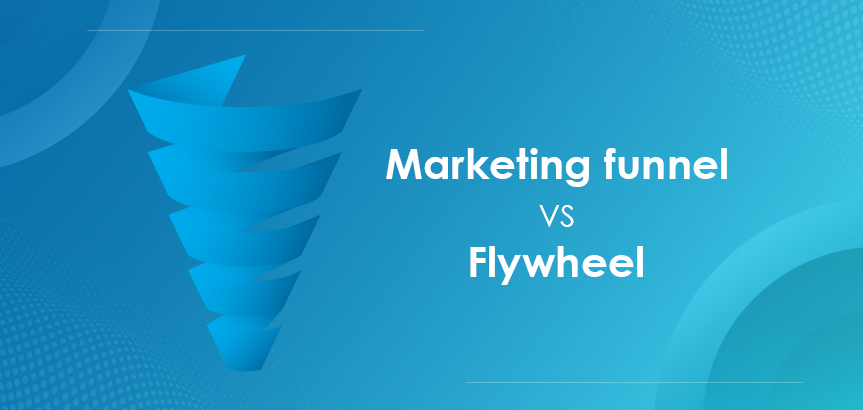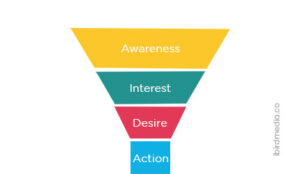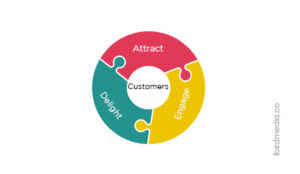
Many corporate ventures rely on efficient business frameworks to get through a fiscal year. Most of these frameworks aim at improving their business prospects. What do you think is their core agenda? Why do the corporate giants implement professionally structured marketing/ sales models for their businesses? To understand these concepts fully, let us start from scratch.
Increasing customer influx, steadily or exponentially, is the key to a corporate’s business growth. In that context, any person or organization interested in your products or services is generally called a lead. Professional marketing and sales tactics can convert these leads into loyal customers. This conversion is often supervised by globally standardized marketing models.
In this blog, we shall compare and contrast two popular marketing/ sales models – Funnel and Flywheel. Besides, you can learn and analyze why Flywheels are the perfect choice for your business planning.
What Are Marketing Funnels? What is Their Mode of Operation?
A marketing funnel thoroughly displays the step-by-step processes involved in transforming a prospect into a client. This model tracks every moment from a potential customer’s initial interest to their first purchase. The pictorial representation of a standard marketing funnel is shown below. Let us analyze it for further insights.

- During the awareness stage, the prospects become aware of your brand’s identity via promotional strategies like social media marketing, email marketing, SMS marketing, content marketing, advertisements, etc. These strategies positively impact a person’s knowledge of your products or services. The leads obtained in this stage are called Information Qualified Leads (IQL).
- After a lead generation, the marketing department interacts with the prospect to keep them intrigued about the company’s market value. This part is called the interest stage. In this stage, a strong business relationship is built between the firm’s representative and the potential client.
- If the IQLs secured in the awareness stage are satisfied with the marketing performance, they might download the product info. At this point, an IQL becomes a Marketing Qualified Leads (MQL). This phase is called the consideration stage. The leads obtained thus are provided with further marketing services or are directed to the sales department.
- A successful business interaction can turn the MQLs into Sales Qualified Leads (SQL) in the action stage. The sales team’s efficiency in closing the leads is proportional to the company’s business growth. They identify high-priority leads and follow up on real opportunities.
You can utilize the collaborative output of the abovementioned stages for implementing effective marketing plans.
Why are Marketing Funnels Not Ideal Anymore?
A Flywheel’s organized approach provides structure to the workflow, making it easier for the various departments to follow through. However, with the advent of more handy and efficient methods of marketing, the funnel model has become outdated.
Let us look at some of the reasons why marketing funnels are no longer in style.
- The one-size-fits-all approach: In the funnel model, prospects enter the awareness stage and convert into customers in the action stage. Often, this is not the case in the present commercial market. In today’s business setup, the prospect can enter the cycle at any stage and convert into a customer. Hence, the linear buying process is one of the major disadvantages of this model.
- A finite end-point: The funnel model puts undue importance on charming prospects into buying products. Most of the company resources are used for the same. The existing customers are not prioritized in the pursuit of new opportunities. As a result, the company fails to retain its customers, and the business growth curve hits a wall.
- Fails to elaborate on the marketing procedures: The structure oversimplifies the entire process from lead generation to customer acquisition. The lack of detailing is hence a flaw of this model.
All these factors put the flywheel marketing model at a disadvantage, making it unfit for incorporation into modern business ventures. This de-merit demands a much more practical model, marketing flywheel, to take over.
Influence Your Corporate Impact with Marketing Flywheels:
Many of you might not be familiar with the physics behind flywheels. A flywheel is a heavy-duty mechanical device that stores its rotational energy to increase the spin momentum. When applied to a business context, the collaborative input of the marketing, sales, and customer relationship management builds momentum for the flywheel’s spin.
While the funnel model focuses on attracting prospective clients, the flywheel scheme invests in improving customers’ shopping experiences. The existing clients are provided with quality service and business offers, leading them to amplify sales via referrals.

A precise overview of the flywheel strategy is given above. As you can see, customers occupy the center of the model. In other words, the business growth plan of a company adopting this framework would be customer-centric. Moreover, the self-sustainable momentum of a flywheel model determines your firm’s success.
The two main principles of marketing flywheel are:
- Application of strategic force: This proposal urges the team leaders or managers of their departments to identify the problem areas and prevent their malfunction. The flywheel derives momentum from this push of force primarily based on attracting and engaging prospects.
- Eliminating unproductive friction: Managerial friction around the marketing and sales branches can affect the smooth functioning of your flywheel. Once you’ve identified the problem areas, you can decide on the ones that require adjustments. Besides, you can also implement corrective measures to aid their executive functioning.
So, what makes marketing flywheel incredibly appealing to modern business setups? Why are the age-old funnel frameworks being replaced by marketing flywheels? Let us find out.
Funnel v/s Flywheel – Understand the Hype Around Marketing Flywheel:
Some of the key takeaways from the duel between the funnel and flywheel marketing models are listed below:
- In a funnel, customers are merely an output of the strategy; in a flywheel, they are the active participants. This customer-centric approach to flywheels caters to the ever-changing demands of a business setup.
- Funnels consume plenty of resources for engaging prospects. But, they fail to establish a solid business relationship between the company and its customers. On the other hand, flywheels operate on the principle of delighting the existing clients of a company. As a result, they refer your brand to their families and acquaintances, offering guaranteed publicity.
- The marketing dynamics continue to grow in the flywheel framework while it comes to a standstill in the funnel model.
To sum it all up, the varying demands of the corporate world require a well-structured operation model. To this effect, marketing flywheels assign a clear-cut sense of direction for your strategies. Customer feedback is critical here, which eventually contributes to business planning. Hence, switching to flywheels would be a sustainable action for your business in the long run.
FAQ:
- How to create a powerful marketing funnel?
- Marketing funnels primarily aim at entertaining the audience into buying products. So, to multiply its efficacy, you must understand your audience thoroughly. The marketing tactics should be built around the diversity of your prospects.
The next step in designing a successful marketing funnel is determining each stage required for your business growth. You can define the stages of awareness, interest, consideration, and action with reference to the nature of your venture.
Lastly, incorporate tried-and-tested marketing strategies into all the stages mentioned above. This approach would help to maintain the pulse of audience engagement.
- How do marketing funnels work?
- The funnel model functions through a precise alignment of four basic components – Awareness, Interest, Consideration, and Action.
The awareness stage is where suitable marketing tools are used to invite the prospect’s attention. This attention is converted to active engagement in the interest stage and further into Marketing Qualified Leads (MQL) in the consideration phase. Finally, these leads can be closed via the sales department in the action phase.
- What are some ways to use the Flywheel Marketing model to deliver a better customer experience?
- Flywheel models implement marketing strategies to nourish and engage existing clients in return for their loyalty. As a result, various departments within the firm adopt a consumer-centric approach to sales and marketing. Prioritizing the clientele feedback and micromanaging these departments lead to an improved customer experience.
- Why should you replace marketing funnels with flywheels?
- Investing more resources in luring prospects than establishing an excellent customer-vendor relationship doesn’t hold much ground in the present business scenario. Since this technique is the foundation for marketing funnels, they have become outdated. On the other hand, the flywheel approach offers ample room for a delighted customer experience. The clients are prioritized at every step of the process, which makes it ideal compared to funnels.


